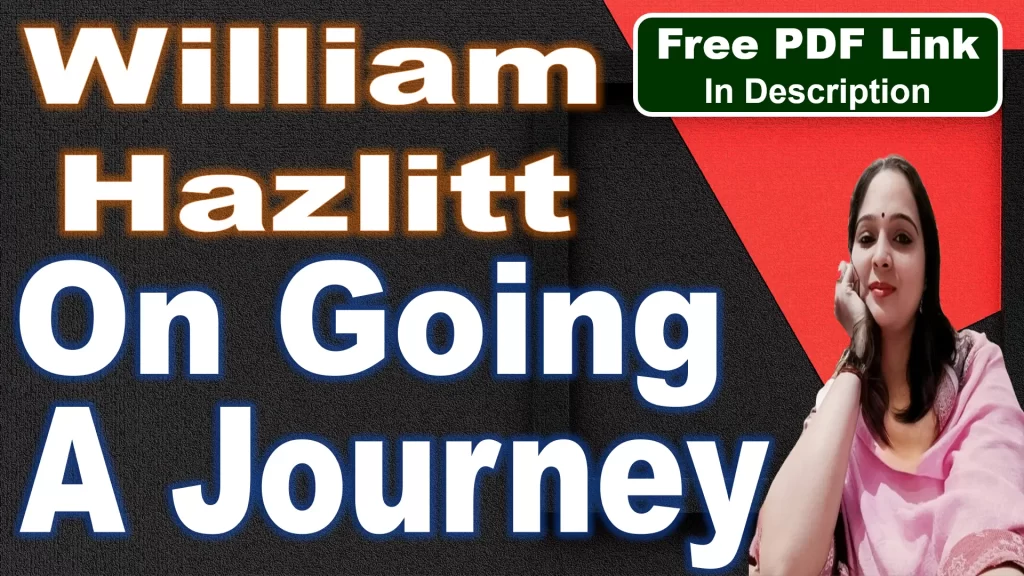
Essay Type Questions
Write the critical appreciation of the Essay “On Going a Journey” by William Hazlitt.
Introduction
“On Going a Journey” by William Hazlitt is one of the finest examples of Romantic-era personal essays, blending travel writing, philosophy, and self-reflection. Published in Table-Talk (1822), the essay is a meditation on the joys of solitary travel, the nature of memory, the contrast between social and individual experiences, and the fleeting nature of beauty and perception. Hazlitt presents a deeply personal argument that traveling alone offers the best form of intellectual and emotional freedom, allowing one to fully immerse in nature and thought without distraction.
Through vivid imagery, philosophical reflections, and personal anecdotes, Hazlitt not only expresses his own love for solitude but also questions human perception, memory, and the limitations of experience. His writing is both poetic and deeply introspective, making this essay a masterpiece of Romantic individualism and self-exploration.
Structure and Style
Hazlitt’s essay does not follow a strict formal structure but rather flows like a personal conversation. It is fragmented yet cohesive, moving through various themes and reflections in a natural, organic way.
Conversational and Reflective Tone → Hazlitt writes as if he is talking to the reader, making complex ideas accessible and engaging.
Use of Literary and Philosophical References → He references John Milton, Coleridge, Laurence Sterne, and others, enriching his argument.
Vivid Descriptions and Metaphors → His imagery—such as the “canvas of the fancy” and the “limb torn off from society”—makes his ideas more powerful.
Personal Anecdotes → He recalls experiences from France, Oxford, inns, and the countryside, making the essay feel authentic and intimate.
Use of Irony and Humor → He criticizes shallow travel companions, bad tour guides, and the limitations of human perception in a witty manner.
Hazlitt’s style is a blend of personal storytelling, poetic prose, and philosophical musings, making On Going a Journey an engaging and thought-provoking read.
Key Themes and Ideas
1. The Joy of Solitary Travel
Hazlitt argues that the best way to travel is alone, as it allows for uninterrupted thought and deep contemplation. He believes that when alone, one is never truly lonely, because nature and one’s own thoughts provide the best company.
He dislikes companions who engage in meaningless talk, as this disrupts his ability to fully absorb the beauty of the landscape.
He compares solitude to freedom, where he can laugh, run, and reflect without inhibition.
The essay reflects Romantic ideals—especially individualism, personal freedom, and deep emotional connection with nature.
Hazlitt’s view is that travel is not just about seeing new places, but about expanding one’s inner world.
2. The Contrast Between Solitude and Society
A major theme in the essay is the tension between personal freedom and social obligations. Hazlitt prefers solitude because it allows him to escape societal pressures.
He dislikes how companions bring back reminders of work, responsibilities, and past experiences, which ruin the purity of travel.
However, he acknowledges that some experiences, like visiting historical sites or traveling abroad, require discussion and companionship.
This contrast reflects a philosophical debate about human nature—is man meant to be a social creature or does true happiness come from solitude and self-reliance?
Hazlitt does not reject human connection entirely, but he believes that too much social interaction takes away the depth of experience.
3. The Role of Memory and Perception
Hazlitt explores how travel alters memory and perception.
He argues that as we move from one place to another, our perception changes, making past experiences fade.
He compares the mind to a canvas, where new images paint over the old ones.
He suggests that travel is both an act of forgetting and rediscovery—we forget the places we leave behind, but we also reawaken old emotions when we return to familiar landscapes.
This idea is deeply philosophical, questioning the nature of memory, time, and how we perceive the world.
4. The Romantic View of Nature
As a Romantic thinker, Hazlitt views nature as a source of inspiration, reflection, and personal freedom.
He describes the blue sky, green turf, winding roads, and rolling clouds in poetic language.
He believes that nature does not need to be analyzed—it should simply be felt and experienced.
His attitude contrasts with scientific or intellectual approaches to nature, which seek to categorize and explain.
This perspective aligns with Romantic poets like Wordsworth and Coleridge, who saw nature as a living, spiritual force.
5. The Fleeting Nature of Beauty and Experience
Hazlitt mourns how beauty and emotions fade over time.
He recalls how, in his youth, he once saw “Liberty, Genius, Love, and Virtue” written in the sky, but as he aged, these ideals faded like illusions.
He suggests that even the most beautiful places and experiences eventually lose their magic as we grow older.
This melancholic reflection adds depth and realism to his essay—travel is not just about pleasure but also about the passing nature of all experiences.
Philosophical and Psychological Insights
Hazlitt’s essay is not just about travel—it is about the human mind, emotions, and how we engage with the world.
He reflects on the limitations of human perception, noting how we can only focus on one place at a time, forgetting everything else.
He explores how solitude enhances creativity and deep thinking, making it essential for writers, philosophers, and artists.
His insights remain timeless, as they explore universal human experiences—freedom, memory, nostalgia, and the search for meaning.
The Essay’s Influence and Legacy
On Going a Journey has inspired many later essayists and travel writers, including:
Robert Louis Stevenson → His essays on wandering and adventure reflect Hazlitt’s love of solitary travel.
Virginia Woolf → She admired Hazlitt’s conversational and introspective writing style.
George Orwell → His blend of personal experience and philosophical reflection was influenced by Hazlitt.
The essay remains relevant today, as it speaks to modern travelers, writers, and anyone who values solitude and deep thought.
Conclusion: The Timelessness of On Going a Journey
William Hazlitt’s essay is more than just a piece about travel—it is a meditation on freedom, self-reflection, and the passage of time. His love for solitary journeys, his dislike of forced conversation, and his deep philosophical insights into memory and perception make this essay a masterpiece of Romantic thought.
His ideas continue to resonate because they touch on universal human experiences—the joy of wandering, the longing for solitude, the struggle between freedom and social obligations, and the bittersweet nature of memory. Hazlitt’s On Going a Journey is not just an essay about places—it is an essay about the mind, the soul, and the essence of what it means to travel, think, and experience the world.
Write long note on William Hazlitt as Essayist.
Introduction
William Hazlitt (1778–1830) is regarded as one of the greatest essayists, critics, and thinkers of the Romantic period. His essays reflect sharp observation, intellectual depth, emotional intensity, and a unique conversational style. He wrote extensively on literature, politics, philosophy, travel, and human nature, blending personal reflection with critical insight. Hazlitt’s essays are highly personal and introspective, making him one of the pioneers of the modern personal essay.
Through works like Table-Talk (1822), The Spirit of the Age (1825), and On the Pleasure of Hating (1826), Hazlitt redefined essay writing, making it a blend of criticism, autobiography, and philosophical exploration. His essays remain relevant today for their brilliance, honesty, and deep understanding of human nature.
Hazlitt’s Style as an Essayist
Hazlitt’s essays are known for their rich language, vivid descriptions, and strong personal voice. His writing style has several distinctive features:
1. Conversational and Personal Tone
Hazlitt’s essays feel like an intimate conversation with the reader.
He often uses “I”, making his work deeply personal and engaging.
He writes as though he is thinking aloud, allowing his thoughts to flow naturally.
Example: In On Going a Journey, he directly shares his emotions:
“One of the pleasantest things in the world is going a journey; but I like to go by myself.”
This direct, simple opening draws the reader into his personal world.
2. Rich Imagery and Vivid Descriptions
Hazlitt had a painter’s eye for detail (he trained as a painter before becoming a writer).
His descriptions of landscapes, people, and experiences are full of color and movement.
His ability to create powerful visual images makes his essays poetic and memorable.
Example: In On the Feeling of Immortality in Youth, he describes youthful hope as:
“Everything seems possible, because we have not tried it and failed.”
3. Deep Psychological and Philosophical Insights
Hazlitt was deeply interested in human nature, emotions, and the workings of the mind.
His essays explore themes of self-awareness, nostalgia, love, envy, hatred, and the fleeting nature of happiness.
He frequently questions traditional ideas and offers sharp, thought-provoking analysis.
Example: In On the Pleasure of Hating, he explores why people enjoy conflict and resentment, exposing the darker side of human emotions.
4. Use of Quotations and Literary References
Hazlitt frequently quotes Shakespeare, Milton, Coleridge, Wordsworth, and classical philosophers.
He uses literary references to support his arguments and enrich his essays.
His deep knowledge of literature and philosophy makes his essays intellectually stimulating.
Example: In On Going a Journey, he quotes Milton, Sterne, and Coleridge to emphasize his ideas about solitude and travel.
5. Strong Opinions and Bold Criticism
Hazlitt was known for his fearless and honest criticism.
He wrote with passion and conviction, attacking what he saw as hypocrisy, pretentiousness, and political injustice.
He criticized poets like Wordsworth and Coleridge, despite once being their admirer, when he felt they had betrayed their ideals.
Example: In The Spirit of the Age, he attacks Lord Byron’s ego and Coleridge’s inconsistency, showing his willingness to challenge literary giants.
Major Themes in Hazlitt’s Essays
1. Individualism and Personal Freedom
Hazlitt believed in the importance of personal liberty and self-expression.
His essays celebrate solitude, independence, and free thinking.
Example: In On Going a Journey, he argues that traveling alone provides the greatest freedom for thought and reflection.
2. Human Nature and Psychology
Hazlitt had a deep understanding of human emotions, weaknesses, and contradictions.
He explored love, hatred, jealousy, ambition, and nostalgia with remarkable insight.
Example: On the Pleasure of Hating examines why people enjoy resentment and conflict, showing his sharp psychological insight.
3. Memory and Nostalgia
Many of Hazlitt’s essays reflect on how memory shapes our identity.
He often writes about past joys, lost ideals, and the passage of time.
Example: In On the Feeling of Immortality in Youth, he beautifully captures the innocence and hope of youth.
4. Politics and Society
Hazlitt was a strong supporter of liberty, democracy, and revolutionary ideals.
He opposed tyranny, monarchy, and conservative politics, which often made him controversial.
Example: In The Spirit of the Age, he criticizes the corruption of political leaders and the failures of intellectuals.
5. Art, Literature, and Criticism
Hazlitt’s essays on Shakespeare, poetry, and painting show his deep appreciation for the arts.
He was one of the first critics to analyze Shakespeare’s characters as real human beings, rather than just literary figures.
Example: In Characters of Shakespeare’s Plays, he discusses Hamlet, Macbeth, and Othello with incredible psychological depth.
Hazlitt’s Influence on Later Essayists
Hazlitt’s essays influenced many later writers and thinkers, including:
Robert Louis Stevenson → His travel essays were inspired by Hazlitt’s love for wandering and adventure.
Virginia Woolf → She admired his conversational style and deep introspection.
George Orwell → His sharp criticism of politics and society followed Hazlitt’s fearless approach.
Ralph Waldo Emerson → Adopted Hazlitt’s focus on individualism and free thought.
Charles Lamb → A close friend of Hazlitt, he shared his passion for personal essays and literary criticism.
Conclusion: Hazlitt’s Legacy as an Essayist
William Hazlitt transformed essay writing, making it a powerful blend of personal reflection, literary criticism, and philosophical inquiry. His essays are intellectually stimulating, emotionally moving, and stylistically brilliant. He remains one of the greatest English essayists, influencing generations of writers and thinkers.
Hazlitt’s ability to combine deep thought with beautiful prose ensures that his essays remain relevant and enjoyable even today. Whether writing about travel, politics, literature, or human nature, he brings a unique passion, insight, and honesty that make his works truly timeless.





